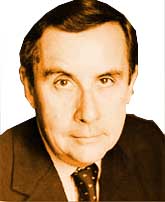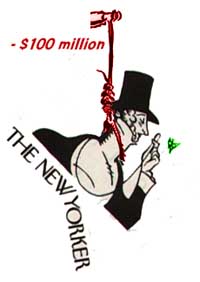|
|
William Pfaff
 The New Yorker sought money, but lost it
The New Yorker sought money, but lost it
PARIS -- It is unseemly to take pleasure in the failures of others, but there is reason to do so in the news that The New Yorker magazine of Tina Brown and S.I. Newhouse, Jr. is a failure.
It has been losing money ever since Mr. Newhouse bought the magazine 13
years ago, and now it is to be folded into the operations of Mr. Newhouse's  other fashion and celebrity magazines.
other fashion and celebrity magazines.
The New Yorker was profitable when the Fleischmann family sold it in 1985. It had become somewhat predictable, and its circulation and profits were in slow decline, but it still was the country's best and most influential magazine.
Its decline, in my view (as a contributor from 1971 to 1985) was due chiefly to its having become an anachronism in an American society greatly changed not only from 1925, when the magazine was founded, but from the 1940s and 1950s when it had found a new voice and authority under the influence of William Shawn, who became editor after the magazine's creator, Harold Ross, died in 1951.
Magazines do have a natural lifespan, connected to the society in which they exist. The New Yorker was a product of a certain America, parochial in its way, but very sure of itself, and sure of its identity, which by the 1980s was dissolving under pressures of cultural ideology and social division in the country, and which by now has all but disappeared.
Today's is a television and entertainment age. The New Yorker was the creation of newspapermen, at a time when Americans read. Harold Ross had been an itinerant newspaperman, an ignorant one, he said, a hick from the west, who was interested in everything, and wanted to learn.
This curiosity made The New Yorker into the most important and original magazine of factual reporting that probably ever existed. Its writers went out to learn about and then write about absolutely any subject that interested them. It was always a writers' magazine. There was plenty of editing (when it was needed), and editorial conflict, but in the end the writer decided.
The newspaper heritage was responsible for the magazine's plain, eloquent, grammatically exact writing. Its understatement was influenced by the midwestern literary naturalism that by the 1920s had become the dominant current in American modernism.
Plain, exact writing was a reaction against the bombast and insincerity of much 19th century "fine" writing, and was also an expression of that American instinct for an accessible "democratic" culture, a plain man's culture, expressed by Lincoln and Twain, among others.
The New Yorker, which Ross sometimes called a "comic paper," by publishing cartoons, humor, news of the racetrack and nightclubs, columns on golf, baseball and football, together with serious non-fiction, and fiction, poetry, and literary and arts criticism, was simultaneously democratic and cosmopolitan.
The legacy of naturalism was responsible for the New Yorker short story, in which, supposedly, nothing happened. Of course a very great deal happened in a New Yorker short story, but the reader was expected to understand what had happened without being told about it. The same was true for The New Yorker sketch, or "casual."
Katherine White, who went to work for Ross six months after the magazine began, was largely responsible for making it the most important influence of its time on American short fiction. She also pushed Ross to publish serious poetry, which, like fiction, has all but disappeared since 1992, when Tina Brown became editor.
What happened to the magazine's fortunes under Mr. Newhouse has a commercial explanation. He purchased it believing that he could reverse its decline and increase its profits. To demonstrate his confidence he raised circulation guarantees and advertising rates. To get the additional circulation he bought it -- which is to say, he sold cheap subscriptions which had to be renewed to become profitable.
He was too proud to back down, so when subscriptions were not renewed he kept buying circulation. It was up to a reported 800,000 last year (as against 500,000 under Mr. Shawn, when the magazine was profitable). But this still is a fickle readership, or the magazine would not have lost $11 million last year -- and a reported $100 million since Mr. Newhouse bought it.
Miss Brown, who is undoubtedly the most brilliant tabloid editor of her day, took the magazine down-market, making it a brilliant and vulgar celebrity, gossip, and insider-dope politics magazine. She said "I do believe in lapses of taste. I firmly do." Her formula, which works elsewhere, has not worked for The New Yorker.
The New Yorker was created to succeed, but from the start commercial and editorial functions were scrupulously separated. No one has ever satisfactorily explained why so fundamentally serious a magazine should have become an enormously successful and profitable consumer magazine. Ross, and then Shawn, simply wanted to do something very good, and did so by letting others do the best work they could do. That is something very rare.
Since Mr. Newhouse and Miss Brown have been in charge, when the only
reason for publishing the magazine has been to make money, it has lost
$100 million. The old New Yorker has its
3/16/98: America's 'strategy of tension' in Italy
3/13/98: Slobodan Milosevic may have started something that can't be stopped